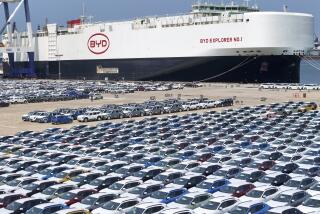Vietnam Out to Pump Up Bike Sales
HANOI â Southeast Asia is turning its back on the trusty vehicle that moved the region into modern times--the bicycle. Bikes have all but vanished from the car-clogged streets of Bangkok, Manila and Jakarta, and they are disappearing fast from other capitals as well.
The only real urban refuge left for bike commuters in Southeast Asia is Vietnam, where the nationâs 30 million bicycles outnumber motor scooters 6 to 1 and cars 60 to 1. Bicycle sales in still-poor Vietnam are close to 1 million a year and growing.
This should provide a bonanza for the state-owned bicycle industry. But domestic sales are flat, accounting for only 15% of the total. And unless Vietnam can find capital to modernize its technology to compete with imports from China, Taiwan and Japan, the industry is in danger of losing its wheels.
âWe are in a market economy now,â said Do Thi Nga, who has spent 36 years in the industry and is general director of Lixeha, a bicycle manufacturer. âWe must pay more attention to quality, to giving consumers a choice of models, to getting the technology other producers use. And to do that, we need a lot of capital.â
*
For the most part, Vietnam still relies on technology that dates back to the mid-1950s, before the era of aluminum rims and titanium frames and multi-gears. The industry has received little investment since the 1980s, and many factories have laid off workers and converted to manufacturing everything from carpets to furniture.
Even the Vietnamese themselves shy away from locally produced bicycles, considering them of poor quality, and prefer the China-made Phoenix, which is often imported illegally without the payment of customs duties. It sells for about $60, is virtually indestructible and comes in a single style--a one-gear model with upright handlebars, old-fashioned brakes and a V-shaped frame that U.S. cyclists would refer to as a womanâs bike.
But the Vietnamese donât complain about the lack of spiffy enhancements that have propelled American manufacturers such as Trek Bicycle Corp. and Cannondale Corp. into profitability. Their need is for bikes that are affordable, utilitarian and rugged--the latter a prerequisite that dates back to the wars against France and the United States, when bicycles played a crucial role in moving food and supplies into the mountains around Dien Bien Phu and down the Ho Chi Minh Trail.
Although seemingly every bike rider in Hanoi aspires to own a Honda Dream motor scooter, the bicycle is still the vehicle that moves this city of 3 million. Professionals in coats and ties and women in fashionable dresses ride bikes to work; children hop on them to go to school. Workers attach carriages and turn them into cargo pickups and taxis. Other laborers pile them so high with sacks of rice and other goods that they must walk alongside, pushing bikes that in effect have become donkeys.
Believing that bicycle sales will continue to grow for many years, Vietnamâs government is taking steps to revive the industry. It plans to inject capital for new production-line machinery and has expressed an interest in forming a joint venture with foreign manufacturers. The state-owned companies, for their part, now try to lure customers with slick brochures and new models, offered in 10 colors instead of just green--a revolutionary change for a Communist country that once didnât give a hoot about buyersâ preferences.
But almost surely the days of the bicycle in Vietnamâs two major cities--Hanoi and the former Saigon, Ho Chi Minh City--are limited, and one day these streets too will grind to a gridlocked standstill, just as thoroughfares already have in other Southeast Asian capitals.
The irony is that the region is abandoning bicycles, and giving in to congestion and pollution, just as Western urban planners are trying to incorporate the bicycle into transportation schemes as a means of making cities more livable. But governments here traditionally have not given environmental concerns high priority. They view the bicycle as part of the past, and that is not a direction they want to travel in their pell-mell rush to develop.
*
John Pucher, an urban planner at Rutgers University in New Jersey, says that in many large European cities, the use of bicycles for commuting has doubled and tripled in recent years. The resurgence, he said, is the direct result of âpublic policies that have greatly enhanced the safety, speed and convenience of bicycling while making auto use more difficult and expensive.â
Bicycling accounts for 30% of all trips in Dutch cities and 20% in Danish cities, and it has risen sharply in Germany, where the government has actively promoted bicycles as an alternative to cars, Pucher writes. In the United States, by contrast, the bicycle accounts for fewer than 1% of urban trips, even though there are 120 million bicycles in the country--more per capita than there are in China, India or Vietnam.
âPeople all over the world are changing back to bicycles,â said Le Thuoc, president of Vietnamâs Vinacycle company. âTheyâre inexpensive, theyâre healthy, and they donât pollute. I imagine, in the years ahead, youâll see fewer bicycles in Hanoi and Ho Chi Minh. But the bicycle got Vietnam to where we are today, and I think weâll still be riding them, especially in the countryside, for a long time to come.â






